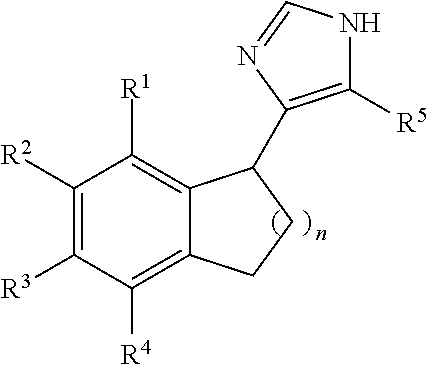Functionally selective alpha2C adrenoreceptor agonists
a technology of adrenergic agonists and alpha2c, which is applied in the field of compounds, can solve the problems of undesirable side effects of compounds having adrenergic activity, such as 2a agonists, and may be associated with undesirable side effects, and achieve the effect of minimizing adverse side effects
- Summary
- Abstract
- Description
- Claims
- Application Information
AI Technical Summary
Benefits of technology
Problems solved by technology
Method used
Image
Examples
example 1
[0259]
Step 1
[0260]
[0261]To a suspension of methoxymethyltriphenylphosphonium chloride (34.8 g, 0.102 mol) in THF (350 ml) was added PhLi (1.8M in tButylether, 56.4 mL, 0.102 mol) slowly at −25° C. The mixture was stirred at −25° C. for 1 h, cooled to −78° C. A suspension of 1A (19.8 g, 0.085 mol, prepared according to the procedure published Khimiya Geterotsiklicheskikh Soedinenii 1975 (8), 1118-20) in THF (300 mL) was added slowly. The mixture was warmed up to RT and stirred for 1 h. The reaction was quenched with saturated NaHCO3, diluted with EtOAc. The organic layer was washed with 1N NaOH, dried over MgSO4, filtered and concentrated in vacuo. Flash chromatography (EtOAc / Hexane 1:1) afforded 1B (10.3 g).
Step 2
[0262]
[0263]1B (10.3 g, 0.0393 mol) was stirred in HCOOH (90%, 150 mL) at 90° C. for 2 h. The mixture was cooled down to RT, diluted with DCM and H2O. The DCM layer was separated, washed with saturated NaHCO3 (2×), brine, dried and concentrated to give 1C (8 g).
Step 3
[0264]...
example 2
[0282]
Steps 1-2
[0283]
[0284]2-indolinone (12 g) was nitrated (40 mL AcOH, 5 mL HNO3) in a manner similar to that described in PCT WO 2001037820. The resulting compound, 5-nitro-2-indolinone, was taken up in EtOH (250 mL) and treated with imidazole-4-carbaldehyde (1 eq) and NaOH (˜10 g). The mixture was stirred at room temperature overnight, neutralized with HCl, and concentrated. The residue was then absorbed onto silica gel and subjected to chromatography (0.25% NH4OH / 10% MeOH in DCM) to provide 2A as a brown solid. MS m / z 257 (MH+).
Step 3
[0285]
[0286]A mixture of compound 2A (1 g), trityl chloride (1 eq), and Et3N (2 mL) in DMF (20 mL) was stirred overnight and then concentrated. The residue was taken up in DCM (50 mL), washed with aq. NaOH, dried over Na2SO4, filtered, and concentrated to provide 2B in quantitative yield.
Step 4
[0287]
[0288]In a manner similar to that described in WO 2007 / 008664, compound 2B is treated with trimethylsulfoxonium iodide and NaH in DMSO to provide 2C.
St...
example 3
[0295]
[0296]Compound 1K (24 mg, 0.038 mmol) was dissolved in DCM (2 mL) and TFA (2 mL). Et3SiH (0.05 mL) was added. The mixture was stirred for 3 h at RT, concentrated in vacuo. Preparative TLC (MeOH (7N NH3) / DCM, 1:10) afforded 3 (6 mg, MH+ 285).
[0297]In a similar manner that described in Example 1 and above, the following compounds were synthesized from 1J by using the indicated reagents:
[0298]
CpdReagentRMS (MH+)3LMeNCO2843MAcetic chloride, Et3N2693NPropionyl chloride, Et3N283
PUM
| Property | Measurement | Unit |
|---|---|---|
| temperature | aaaaa | aaaaa |
| α-adrenergic | aaaaa | aaaaa |
| intraocular pressure | aaaaa | aaaaa |
Abstract
Description
Claims
Application Information
 Login to View More
Login to View More - R&D
- Intellectual Property
- Life Sciences
- Materials
- Tech Scout
- Unparalleled Data Quality
- Higher Quality Content
- 60% Fewer Hallucinations
Browse by: Latest US Patents, China's latest patents, Technical Efficacy Thesaurus, Application Domain, Technology Topic, Popular Technical Reports.
© 2025 PatSnap. All rights reserved.Legal|Privacy policy|Modern Slavery Act Transparency Statement|Sitemap|About US| Contact US: help@patsnap.com



